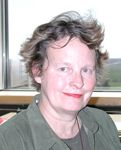RTB is making a concerted effort to get researchers and partners to recognize the central role that women play in food security and livelihoods, and to consider the perspectives of both men and women in their work. At a two-day meeting in Montpellier, in December, participants discussed ways to adapt the program’s gender strategy to the different crops and regions, and incorporate it into the RTB impact pathways. We interviewed two gender specialists who participated in the meeting and are guiding this process: Eva Rathgeber, an international consultant and adjunct professor at the University of Ottawa and Carleton University, in Canada, and Kayte Meola, a sociologist with a PhD from Cornell University who serves as the gender focal point at CIAT.
| 1. Tell us about your background and experience working on gender issues | |
| ER: I am a social scientist and now work as an international consultant mostly with the CGIAR and with the UN system. I worked with IDRC (Canada’s International Development Research Centre) for 20 years, including a decade based in Nairobi. After leaving IDRC, I held the joint Chair of Women’s Studies at Carleton University and the University of Ottawa, in Canada, for several years, and I continue to be an Adjunct Professor there. I work on social aspects of natural resource management, research management, and ICTs as tools for empowerment. Also, I am currently the Chair of the Steering Committee of the Gender and Water Alliance (GWA), a network of 2000+ water professionals in 130 countries. | KM: I am a development sociologist with a PhD from Cornell University’s Development Sociology Program, where I specialized in gender and the environment. For my doctoral dissertation, I analyzed the impacts of participatory conservation on gender structure in a sustainable development reserve in Amazonas, Brazil. This involved investigating the effects of conservation interventions on the gender division of labor, women’s leadership, and household structure. I found that that participatory conservation projects, which introduce or reinforce exogenous institutions and cultural ideologies, can create fundamental, unintended shifts in local social organization. Previously, I also conducted a study on the differential impacts of an environmental education program on men’s and women’s behavior in a Honduran biosphere reserve. |
| 2. How are you involved with the RTB Program? | |
| ER: I work specifically on RTB and gender. I have helped finalize the gender strategy and reviewed some of CIP’s earlier work on gender. | KM: I am the gender focal point at CIAT, specifically working for the RTB Program and focusing on cassava. I am conducting a gender baseline review, working on integrating gender into flagship products, and generally helping CIAT mainstream gender. |
| 3. Where do you think the gender opportunities in RTB lie? | |
|
ER: I found very little literature on gender and RTB, and what little I did find were primarily technical studies. We need to build a social perspective on this technical work. In my experience, women are very involved in the production of cassava and sweet potato. But they tend to become men’s crops as soon as they become profitable, so we should make sure women do not get ‘squeezed out’. They have a central role to play in food security and livelihoods. Both men and women should be involved at all levels of the RTB value chain. I am glad to see that the RTB management recognizes the opportunities as well as potential problems.
The big challenge will be to get the researchers and partners to incorporate these social issues into their work. I was glad to see the support and interest shown by the workshop participants. It will be important for them to encourage partners, especially the NARS, to also incorporate a gender perspective.
|
KM: Gender certainly does make sense for the RTB Program, where people will have to pay more attention to social differences as the program progresses. RTB work will impact the division of labor, which tends to be differentiated by gender. Technologies developed and delivered through RTB will provide benefits, but we have to take into account gender differences. It’s not just about increasing the positive impact of these technologies, but also minimizing any negative impacts they could potentially have. |
| 4. What do you think the biggest challenges are? What potential threats should the RTB team be aware of, and what pitfalls should they avoid? | |
| ER: Definitely there is pressure to deliver quickly. However, this kind of work requires bringing new ideas and new partners on board which takes time and effort, and doesn’t necessarily pay off quickly. I think the RTB team should ensure that there is regular monitoring and evaluation of the gender component of the work, to ensure that it receives sufficient attention throughout the projects. Too often gender is present at the beginning and sometimes at the end, but does not receive sufficient attention during the actual implementation of the project. It does require technical expertise and I know that the RTB team is planning to appoint a Gender Coordinator to address this problem. | KM: One challenging question would be: If the RTB Program improves the commercialization of traditional crops, could women lose a source of labor? We have to consider whether there would be better alternatives for women. There is a potential for loss of livelihoods, and to prevent this there needs to be adequate collaboration between the CGIAR research programs and partners doing extension and development work. Alternatives should be made available, and I believe building partnerships with local development organizations will be key to ensuring the success of the endeavor. We should also monitor and evaluate the value chain and product outcome from a gender perspective. |
| 5. What are your impressions of the meeting? | |
| ER: I think the discussions that went on could lead to new insights. For example, the role-playing exercise certainly revealed stereotypes, and for an hour, scientists moved outside their usual conceptual framework. I hope that the meeting will lead to more input into the gender strategy and that ultimately scientists will buy into the strategy and use it in their work. I am glad to see that the CGIAR system is doing gender work, and the consortium seems to be very serious about it. There is now a comprehensive set of guidelines.I have known the CGIAR system since 1979, and this one is the most intense and concerted efforts ever made to bring in gender; we have a high-level commitment backed by technical expertise and money. Of course, it won’t happen overnight, but in my 30 years working on and off on gender, I’ve seen changes happen in the scientific arena. For example, younger male scientists are now used to seeing women with leadership roles in higher education and in research and many, if not most, feel very comfortable working in teams that include both men and women. I think this is a great opportunity for the system as a whole to act upon the recognition that research in agriculture needs to give consideration to the needs and perspectives of all farmers, men and women. | KM: It was a great workshop. There was a genuine interest in gender among the participants. I would now encourage the CGIAR centers to increase communication regarding their gender strategies and activities. This is a golden moment for mainstreaming gender within the CGIAR. Let’s keep the momentum going!
Some recommended links:
|
Interviews by Véronique Durroux-Malpartida, December 2012


